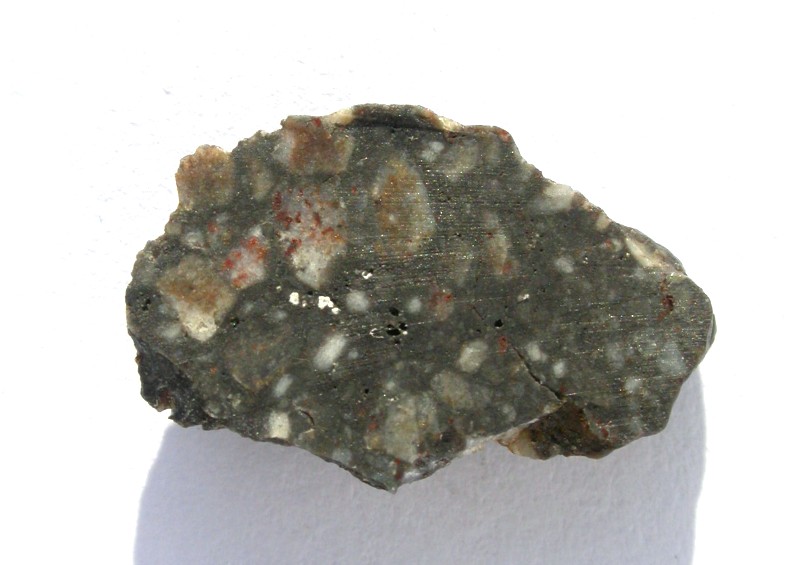|
|
本帖最后由 love20075 于 2013-9-9 15:52 编辑

月球陨石密度:2.7g/cm3——3.8g/cm3
孔隙度,磁化率和
月球陨石的密度。
R. J. MACKE的
1
, D. T.布里特
1
, W. S.基弗
2
A. J.欧文,
3
和G J.
Consolmagno
4
。
1
佛罗里达中央大学物理系。
邮箱: macke@jesuits.net :
2
月球和行星研究所。
3
部
,西雅图华盛顿大学地球与空间科学。
4
Specola梵蒂冈。
简介:重力和地形数据的月球任务的解释月球的内部模型
需要一个全面的数据库月球岩石的密度和
孔隙度。到目前为止,我们已经五阿波罗月球样本和50个石头的孔隙度,密度和磁化率测量
从44 74已知的月球陨石,较广泛
岩性和月球区域范围。我们的测量方法概述[1]中的速度快,非破坏性和无污染。粮食氦理想气体密度的测量
测比重,体积密度开发人员,通过玻璃珠法
[2]。散货和粮食密度,孔隙率直接计算。
而且,我们测量磁化率,使用SM - 30磁化率仪[3] 。
玄武岩:低钛( 1-5%二氧化钛
这里测量)玄武岩
集团紧紧颗粒密度(平均为3.30 ± 0.06克厘米
-3
)和磁化率(日志χ = 2.86 ±0.11) 。孔隙度为
零到10 % ,平均为5.6 % 。有没有明显的区别
两者之间的阿波罗的玄武岩( 12051和15555 )和六个
作为一个整体的玄武岩陨石。
长石角砾岩:密度平均为( 2.85 ± 0.11 )
克厘米
-3
。磁化率在很宽的范围内变化,从
登录χ = 2.1 〜4.5。两个截然不同的群体是可见的孔隙率,与大多数在8%以下的多孔质,但有几个(最显着的所有
石头的配对NWA 2995/2996/4503/5151/6252 )有
孔隙度超过10% 。这些样本代表了混合壤角砾岩,破碎角砾岩和冲击熔融角砾岩。
其他角砾岩:岩性多样(包括富含KREEP
角砾)占据不同范围的密度和磁化率比其他两个组。在这组的陨石
具有低孔隙度(像felsdpathic的角砾岩和玄武岩) ,但
相反阿波罗角砾岩〜 15 %以上的孔隙率。
讨论:这里给出的数据是一个早期的结果
正在进行的研究。但仍有许多工作有待完成,包括
进一步测量,已经在陨石和进度
阿波罗样品。扩大数据库阿波罗样品会
有关的孔隙率在原地而不是陨石角砾岩角砾岩帮助解决问题。它也将填补丢失的数据
列入如此远没有律师代表的高钛(9-14 %(重量)二氧化钛
)
玄武岩以及扩大低钛玄武岩的代表性。
此外,阿波罗样品中已知的地质上下文
包括岩性,尚未确认在月球
陨石收集。
致谢: CAPTEM ,卡罗琳·史密斯( NHM ) ,卡尔
阿吉(UNM ) ,凯文·点对点( NASA - JSC ) ,特德黄沙( NAU)
WUSTL :兰迪Korotev ( ),伊恩·尼克林(ROM),菲利普·玛尼
格雷戈里Hupé ,唐·爱德华兹,安德鲁·亚伯拉罕。美国航空航天局
行星地质与地球物理研究所项目资助
NNX09AD91G 。
参考文献: [1 ] Consolmagno G. J.等人。 2008年。化学DER
王尔德 - 地球化学68:1-29 。 [2] Consolmagno G. J.和布里特D.
T. 1998 。陨星与行星科学33:1231-1241 。 [3 ] Gattacceca J.等人。 2004地球物理学报158:42 -
POROSITY, MAGNETIC SUSCEPTIBILITY AND
DENSITY OF LUNAR METEORITES.
R. J. Macke
1
, D. T. Britt
1
, W. S. Kiefer
2
, A. J. Irving
3
, and G. J.
Consolmagno
4
.
1
Dept. of Physics, University of Central Florida.
E-mail: macke@jesuits.net.
2
Lunar and Planetary Institute.
3
Dept.
of Earth and Space Sciences, University of Washington Seattle.
4
Specola Vaticana.
Introduction: The interpretation of gravimetric and topographical data from lunar missions to model the Moon’s interior
requires a comprehensive database of lunar rock densities and
porosities. To date we have measured porosity, density and magnetic susceptibility for five Apollo lunar samples and 50 stones
from 44 of the 74 known lunar meteorites, representing a wide
range of lithologies and lunar regions. Our measurement methods as outlined in [1] are fast, non-destructive and noncontaminating. Grain density is measured by helium ideal-gas
pycnometry, bulk density by the glass bead method developed by
[2]. Porosity is calculated directly from bulk and grain densities.
We also measure magnetic susceptibility, using an SM-30 magnetic susceptibility meter [3].
Basalts: The low-Ti (1-5 wt% TiO2
) basalts measured here
group tightly in grain density (avg. 3.30 ± 0.06 g cm
-3
) and magnetic susceptibility (log χ = 2.86 ± 0.11). Porosities range from
zero to 10%, averaging 5.6%. There is no discernible difference
between the two Apollo basalts (12051 and 15555) and the six
basaltic meteorites taken as a whole.
Feldspathic Breccias: Grain densities averaged 2.85 ± 0.11
g cm
-3
. Magnetic susceptibilities varied over a wide range, from
log χ = 2.1 to 4.5. Two distinct populations are visible in porosity, with most below 8% porous, but a few (most notably all
stones of the pairing NWA 2995/2996/4503/5151/6252) have a
porosity in excess of 10%. These samples represent a mix of regolith breccias, fragmental breccias, and impact-melt breccias.
Other Breccias: Diverse lithologies (including KREEP-rich
breccias) occupy a different range of density and magnetic susceptibility than the other two groups. The meteorites in this group
have low porosities (like the felsdpathic breccias and basalts), but
in contrast Apollo breccias have porosities above ~15%.
Discussion: The data presented here are early results of an
ongoing study. Much work still remains to be done, including
further measurements already in progress of both meteorites and
Apollo samples. Expanding the database of Apollo samples will
help address issues about the porosity of in-situ breccias as opposed to meteorite breccias. It will also fill in missing data with
the inclusion of thus-far unrepresented high-Ti (9-14 wt% TiO2
)
basalts as well as expanding the representation of low-Ti basalts.
In addition, the Apollo samples have known geologic contexts
and include lithologies that have not been recognized in the lunar
meteorite collection.
Acknowledgments: CAPTEM, Caroline Smith (NHM), Carl
Agee (UNM), Kevin Righter (NASA-JSC), Ted Bunch (NAU),
Randy Korotev (WUSTL), Ian Nicklin (ROM), Philip Mani,
Gregory Hupé, Don Edwards, and Andrew Abraham. NASA
Planetary Geology and Geophysics Program grant
NNX09AD91G.
References: [1] Consolmagno G. J. et al. 2008. Chemie der
Erde - Geochemistry 68:1-29. [2] Consolmagno G. J. and Britt D.
T. 1998. Meteoritics & Planetary Science 33:1231-1241. [3] Gattacceca J. et al. 2004. Geophysical Journal International 158:42
|
评分
-
查看全部评分
|
 |Archiver|手机版|中陨网✪国陨网
( 冀ICP备10012798号-1 )
|Archiver|手机版|中陨网✪国陨网
( 冀ICP备10012798号-1 )